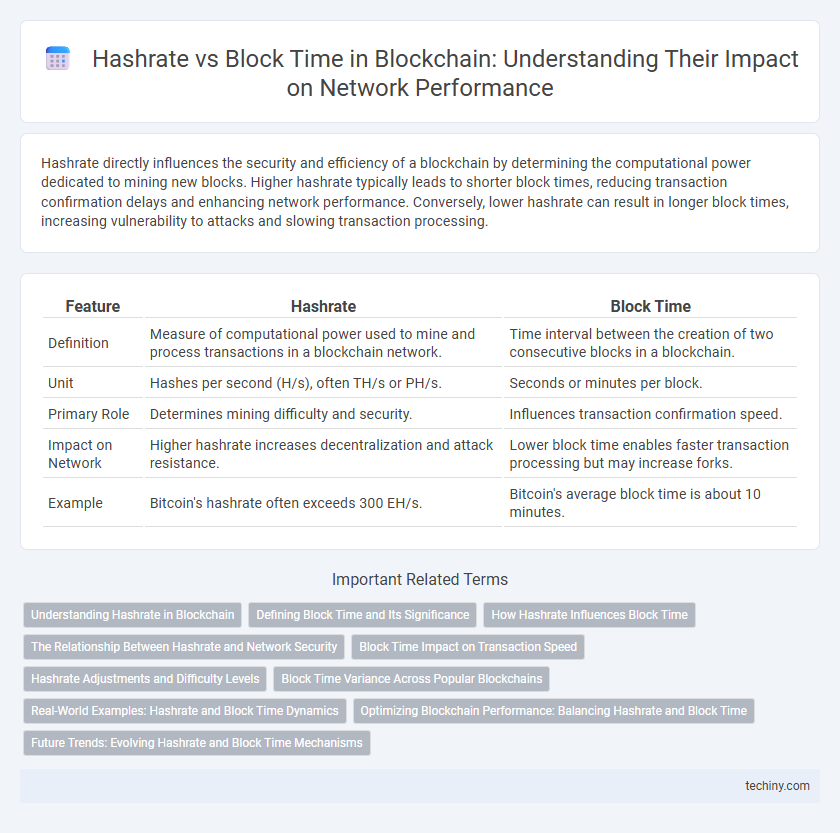Hashrate directly influences the security and efficiency of a blockchain by determining the computational power dedicated to mining new blocks. Higher hashrate typically leads to shorter block times, reducing transaction confirmation delays and enhancing network performance. Conversely, lower hashrate can result in longer block times, increasing vulnerability to attacks and slowing transaction processing.
Table of Comparison
| Feature | Hashrate | Block Time |
|---|---|---|
| Definition | Measure of computational power used to mine and process transactions in a blockchain network. | Time interval between the creation of two consecutive blocks in a blockchain. |
| Unit | Hashes per second (H/s), often TH/s or PH/s. | Seconds or minutes per block. |
| Primary Role | Determines mining difficulty and security. | Influences transaction confirmation speed. |
| Impact on Network | Higher hashrate increases decentralization and attack resistance. | Lower block time enables faster transaction processing but may increase forks. |
| Example | Bitcoin's hashrate often exceeds 300 EH/s. | Bitcoin's average block time is about 10 minutes. |
Understanding Hashrate in Blockchain
Hashrate measures the computational power used by miners to solve cryptographic puzzles and validate transactions in a blockchain network. A higher hashrate increases network security by making it more difficult for attackers to manipulate the blockchain, directly influencing the speed at which new blocks are generated. Understanding hashrate is essential for assessing the health, efficiency, and resistance of a blockchain to 51% attacks.
Defining Block Time and Its Significance
Block time is the average duration it takes for a new block to be added to a blockchain, directly influencing the network's transaction processing speed and security. It serves as a crucial metric for measuring throughput, impacting confirmation times and miner rewards. Shorter block times can increase transaction throughput but may raise the risk of orphaned blocks, while longer block times enhance security and stability.
How Hashrate Influences Block Time
Higher hashrate increases the network's total computational power, allowing miners to solve cryptographic puzzles more quickly, which typically reduces the average block time. When hashrate spikes, the difficulty adjustment algorithm in most blockchains recalibrates to maintain a consistent block time target, preventing blocks from being found too rapidly. Therefore, hashrate directly affects block time volatility before difficulty retargeting stabilizes block interval duration.
The Relationship Between Hashrate and Network Security
Hashrate directly influences network security by determining the computational power available to validate transactions and secure the blockchain against attacks. Higher hashrate enhances resistance to double-spending and 51% attacks by increasing the effort required to alter blocks. Block time remains consistent, but a rising hashrate strengthens the overall robustness and integrity of the blockchain network.
Block Time Impact on Transaction Speed
Block time directly influences the speed at which transactions are confirmed on a blockchain network, with shorter block times enabling faster transaction processing and increased throughput. Higher hashrate contributes to network security and mining efficiency but does not reduce block time, which is protocol-dependent and typically set by blockchain consensus mechanisms. Optimizing block time balances network security and transaction speed, impacting user experience and scalability.
Hashrate Adjustments and Difficulty Levels
Hashrate adjustments directly influence difficulty levels to maintain consistent block time in blockchain networks. When hashrate increases, difficulty rises to prevent faster block creation, ensuring network stability. Conversely, a drop in hashrate lowers difficulty, allowing block time to stay within target parameters.
Block Time Variance Across Popular Blockchains
Block time variance across popular blockchains directly impacts transaction speed and network security, with Bitcoin averaging around 10 minutes, Ethereum approximately 13 seconds post-Merge, and Solana targeting sub-1-second intervals. Higher hashrate generally stabilizes block time by increasing network difficulty, as seen in Bitcoin's steady block intervals despite growing mining power. This variance influences scalability and user experience, making block time a critical metric for evaluating blockchain performance.
Real-World Examples: Hashrate and Block Time Dynamics
Bitcoin's hashrate fluctuates significantly, impacting its average block time, which targets roughly 10 minutes but can vary due to mining difficulty adjustments. Ethereum's transition to Proof of Stake drastically reduced energy consumption and stabilized block time around 12 seconds, decoupling it from hashrate volatility seen in Proof of Work systems. Real-world data from these networks illustrate how hashrate fluctuations influence mining efficiency and transaction processing speed in Proof of Work blockchains.
Optimizing Blockchain Performance: Balancing Hashrate and Block Time
Optimizing blockchain performance requires a careful balance between hashrate and block time to enhance network security and transaction throughput. A higher hashrate increases the network's resistance to attacks by making mining more competitive, while shorter block times improve transaction confirmation speed but may lead to more orphaned blocks. Achieving the optimal equilibrium ensures efficient consensus, minimizes latency, and maintains decentralization, which is critical for scalable and secure blockchain operations.
Future Trends: Evolving Hashrate and Block Time Mechanisms
Future trends in blockchain technology indicate a dynamic evolution of hashrate and block time mechanisms driven by increasing network scalability and energy efficiency demands. Innovations like adaptive difficulty algorithms and proof-of-stake models aim to optimize hashrate distribution while minimizing block time variability. These advancements enhance transaction throughput and security, positioning blockchain networks for sustainable growth amid expanding user bases and decentralized applications.
Hashrate vs Block Time Infographic

 techiny.com
techiny.com